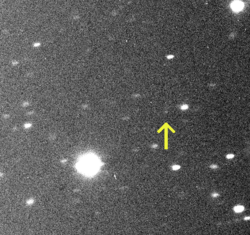Astronomy:Arche (moon)
 Discovery image of Arche by the University of Hawaii telescope in October 2002 | |
| Discovery | |
|---|---|
| Discovered by | Scott S. Sheppard |
| Discovery site | Mauna Kea Obs. |
| Discovery date | 31 October 2002 |
| Designations | |
Designation | Jupiter XLIII |
| Pronunciation | /ˈɑːrkiː/ |
| Named after | Αρχή Archē |
| S/2002 J 1 | |
| Adjectives | Archean /ɑːrˈkiːən/ |
| Orbital characteristics [1] | |
| 22931000 km | |
| Eccentricity | 0.259 |
| Orbital period | −723.9 days |
| Mean anomaly | 126.7° |
| Inclination | 165.0° |
| Longitude of ascending node | 350.7° |
| 161.1° | |
| Satellite of | Jupiter |
| Group | Carme group |
| Physical characteristics | |
| Mean diameter | 3 km |
| Apparent magnitude | 22.8 |
Arche /ˈɑːrkiː/, also known as Jupiter XLIII, is a moon of Jupiter. It was discovered by a team of astronomers from the University of Hawaii led by Scott S. Sheppard on 31 October 2002, and received the temporary designation S/2002 J 1.[2][3]
Arche is about 3 kilometres in diameter, and orbits Jupiter at an average distance of 23,717,000 km in 746.185 days, at an inclination of 165° to the ecliptic (162° to Jupiter's equator), in a retrograde direction and with an eccentricity of 0.149.
It was named in 2005 after Arche, whom some Greek writers described as one of the four original Muses, an addition to the earlier three (Aoede, Melete, and Mneme).[4]
Arche belongs to the Carme group, made up of irregular retrograde moons orbiting Jupiter at a distance ranging between 23 and 24 Gm and at an inclination of about 165°.
References
- ↑ S.S. Sheppard (2019), Moons of Jupiter, Carnegie Science, on line
- ↑ IAUC 8035: S/2002 J 1 2002 December 18 (discovery)
- ↑ MPEC 2002-Y22: S/2002 J 1 2002 December 18 (discovery and ephemeris)
- ↑ IAUC 8502: Satellites of Jupiter 2005 March 30 (naming the moon)
 |
